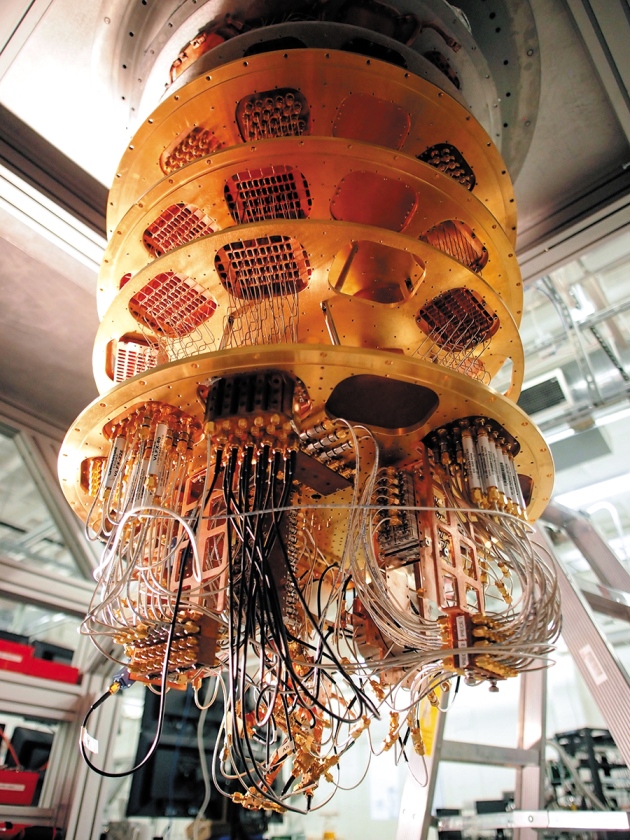Commercialize quantum technologies in five years
Masoud Mohseni, Peter Read, Hartmut Neven and colleagues at Google's Quantum AI Laboratory set out investment opportunities on the road to the ultimate quantum machines.

Google's cryostats reach temperatures of 10 millikelvin to run its quantum processors.
From aspects of quantum entanglement to chemical reactions with large molecules, many features of the world cannot be described efficiently with conventional computers based on binary logic. The solution, as physicist Richard Feynman realized three decades ago1, is to use quantum processors that adopt a blend of classical states simultaneously, as matter does. Many technical hurdles must be overcome for such quantum machines to be practical, however. These include noise control and improving the fidelity of operations acting on the quantum states that encode the information.
The quantum-computing community is channelling most of its efforts towards building the ultimate machine: a digital quantum computer that tolerates noise and errors, and that in principle can be applied to any problem. In theory, such a machine — which will need large processors comprising many quantum bits, or qubits — should be able to calculate faster than a conventional computer. Such capability is at least a decade away2.
Correcting for errors requires redundancy, and the number of qubits needed quickly mounts. For example, factorizing a 2,000-bit number in one day, a task believed to be intractable using classical computers3, would take 100 million qubits, even if individual quantum operations failed just once in every 10,000 operations. We have yet to assemble digital quantum processors with tens of qubits.
This conservative view of quantum computing gives the impression that investors will benefit only in the long term. We contend that short-term returns are possible with the small devices that will emerge within the next five years, even though these will lack full error correction.
A lack of theoretical guarantees need not preclude success. Heuristic 'hybrid' methods that blend quantum and classical approaches could be the foundation for powerful future applications. The recent success of neural networks in machine learning is a good example. In the 1990s, when the computing power required to train deep neural networks was unavailable, it was fashionable in the field to focus on 'convex' methods (based on functions with a clear minimum solution) that had a strong theoretical basis. Today, these methods are no match for deep learning. The underlying algorithms of neural networks have hardly changed, yet impressive new performance milestones are being reached, thanks to 'Moore's law'.
Similarly, although there is no proof today that imperfect quantum machines can compute fast enough to solve practical problems, that may change. The scale, fidelity and controllability of analog and digital quantum hardware are improving steadily. We anticipate that, within a few years, well-controlled quantum systems may be able to perform certain tasks much faster than conventional computers based on CMOS (complementary metal oxide–semiconductor) technology.
Here we highlight three commercially viable uses for early quantum-computing devices: quantum simulation, quantum-assisted optimization and quantum sampling. Faster computing speeds in these areas would be commercially advantageous in sectors from artificial intelligence to finance and health care.
Capitalizing on imminent advances in quantum technologies requires that the discipline broadens its focus and that scientists work more closely with entrepreneurs. Hardware improvements are needed to make devices reliable and controllable enough to be commercialized. Heuristic quantum algorithms need to be developed that address practical problems within the current hardware limitations. As researchers working on quantum computing at Google, we plan to provide access to our quantum processors through cloud services to facilitate the development and benchmarking of quantum algorithms and applications across industries, delivering real benefit to society.
Three priorities
If certain feasible technological improvements are achieved, we believe that emerging quantum processors have a good chance of carrying out the following classes of computational tasks and could become commercially valuable within a few years.
Quantum simulation.
Modelling chemical reactions and materials is one of the most anticipated applications of quantum computing. Instead of spending years, and hundreds of millions of dollars, making and characterizing a handful of materials, researchers could study millions of candidates in silico. Whether the aim is stronger polymers for aeroplanes, more-effective catalytic converters for cars, more-efficient materials for solar cells, better pharmaceuticals or more-breathable fabrics, faster discovery pipelines will bring enormous value.
Computational materials discovery is already a large industry. Quantum computers promise a radical transition: from the qualitative and descriptive to the quantitative and predictive. Chemical-reaction rates are extremely sensitive to molecular energies and span a range wider than classical methods can handle. If robust algorithms are developed, it might be possible to simulate important materials without the overhead of full quantum error correction4. For example, algorithms are already known (such as the 'quantum variational eigensolver' approach) that seem to be immune to qubit control errors.
A variety of business models could supply quantum simulators. Laboratories might pay a subscription for access. Computing companies could act as consultants. Some businesses might exchange equity in return for quantum-assisted breakthroughs that lead to innovative material developments....MUCH MORE